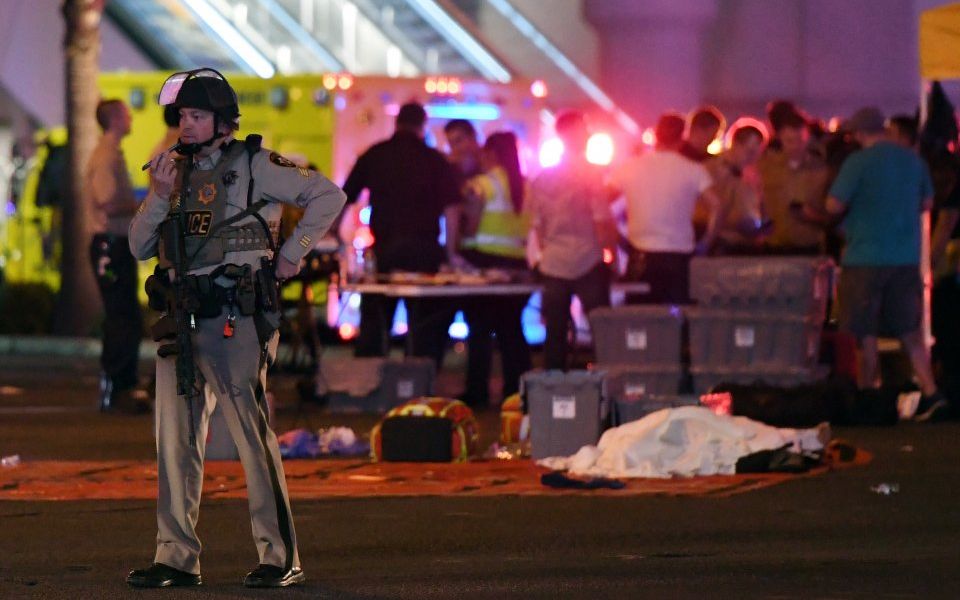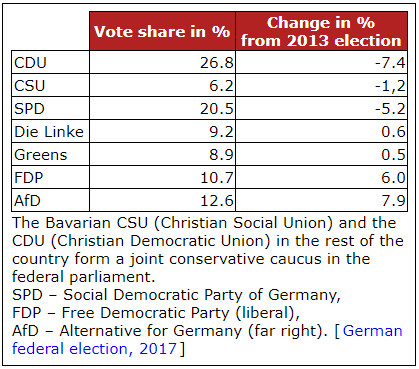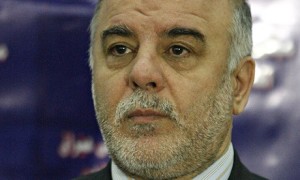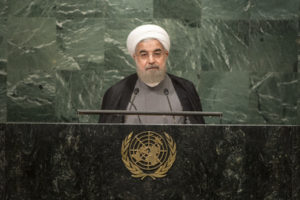Ken Kramer grew up in the 1950s and 1960s in Houston. As a child he spent a lot of time on Galveston, an island about 50 miles away in the Gulf of Mexico. Kramer experienced Hurricane Carla in 1961 with gusts of 175 mph and a storm surge of 22 feet. It destroyed 120 buildings on Galveston, though the eye was 120 miles away. He also studied the 1900 storm that devastated the island. The Great Hurricane of Galveston is still the worst humanitarian, natural disaster in U.S. history. Somewhere between 8,000 and 12,000 people were killed.
That’s why Kramer, who was statewide executive director of the Texas chapter of the Sierra Club for 23 years, was first alarmed in 2003 when he learned that the U.S. federal government chose Galveston as the site for a national biocontainment laboratory.
On the site would be a Bio-safety Level 4 lab, the highest grade of precaution taken to work with agents, such as anthrax, ebola and SARs, which can be transmitted through the air and cause fatal diseases in humans for which there are no known cures. The national laboratory’s primary mission would be to develop vaccines against a perceived threat of terrorists deploying biological weapons in the wake of 9/11. Galveston was one of two such post-9/11 labs built. The other is in Boston.
Two months before the Galveston National Laboratory (GNL) was to open on the campus of the University of Texas Medical Branch (UTMB), the island took a direct hit from Hurricane Ike on Sept. 13, 2008.
The GNL’s website says the lab can withstand a Category 5 storm and 140 mph winds, though Category 5 storms on the Saffir–Simpson wind scale begin at 157 mph. Though Ike flooded most of Galveston and damaged university back-up generators, the Category 2 storm packed only 100 mph winds, which the lab buildings withstood.
“Hurricane Ike was devastating,” David Walker, director of UTMB’s Center for Biodefense and Emerging Infectious Diseases, told the Texas Medical Center magazine. “But there was one really good outcome, an unmitigated, beneficial effect: it proved that the GNL had been designed appropriately. It was the only building that was completely undamaged. Everyone was criticizing us for building a BSL4 lab on a barrier island that’s constantly hit by hurricanes, but this proved that we had designed our facility soundly and it could function safely.”
That did not soothe Kramer, however.
“The University of Texas should consider locating its biohazards lab away from Galveston Island and out of harm’s way,” he told The New York Times six weeks later, on Oct. 28, 2008. “As destructive as it was, Hurricane Ike was only a Category 2 storm. A more powerful storm would pose an even greater threat of a biohazards release.”
Hurricane Harvey
That more powerful storm hit Texas nine years later, on Aug. 25. It was the first big test for the lab. Though Hurricane Harvey’s eye struck 200 miles away from Galveston in Rockport, Texas, it was a massive storm that stretched nearly the entire coastline from Mexico to Louisiana. It packed 130 mph winds as it hit the Texas coast, just 10 mph below GNL’s threshold. Amid apocalyptic scenes of flooding in Houston, reporters from both Fox and CNN said they could not reach Galveston. Little news was coming from the island, and not a word about the lab.

Galveston National Laboratory. (Photo credit Galveston National Library)
After placing a phone call to the lab that was not returned, I wrote an article on Aug. 30 raising concern. I cited Kramer’s remarks to The New York Times and those by Jim Blackburn, an environmental lawyer in Houston, who had told the paper that placing the lab on Galveston is “crazy, in my mind. I just find an amazing willingness among the people on the Texas coast to accept risks that a lot of people in the country would not accept.”
I interviewed Prof. Francis Boyle, who wrote the U.S. implementing legislation for the Biological Warfare Convention. He expressed concern for a power failure that could disrupt the containment system.
My piece prompted the university’s public relations office to issue its first statement, five days after the storm had hit. It said there had been no damage and admitted the statement had only been issued in reaction to my article (although the statement mischaracterized what my article had said.)
“There are inaccurate reports that the Galveston National Laboratory (GNL) at The University of Texas Medical Branch at Galveston may have been compromised because of Hurricane Harvey,” the statement said. “These false reports do a disservice to all of the people in our community and the dedicated scientists and workers on staff at the GNL.”
Two weeks after the storm, Kramer, the former Sierra Club official, spoke out again about the lab. He told me he had lost none of his concerns before and after Harvey hit.
“My reaction when I first heard that the bio hazards lab had been located in Galveston was, ‘Say what? That’s crazy.’ That’s still my feeling,” he said in an email. “I think that was a questionable decision.”
Kramer said this time luck was on the lab’s side.
“Since Galveston did not get the direct hit & full force hurricane winds that Rockport got, the lab building did not face that issue, which would have been a major concern,” he said. “Some buildings on the TX coast that were in the direct hit zone apparently did not meet their ratings for withstanding hurricane winds.”
Harvey packed 130 mph winds as it hit the Texas coast. This is just 10 mph below GNL’s threshold, had it struck Galveston instead.
Kramer added:
“It’s hard to know what effect Hurricane Harvey had on the lab w/o more details coming from the lab.”
The Director Speaks
Some of those details were offered by James LeDuc, the lab’s director, in written responses to me eight days after I submitted questions on Aug. 31. LeDuc is a 23-year career Army officer in the medical research and development command. He’s been based at the Walter Reed Army Institute of Research and the U.S. Army Medical Research Institute of Infectious Diseases, as well as in Central and South America. He was the Influenza Coordinator at Centers for Disease Control and Prevention (CDC) in Atlanta, and in the 1990s worked for the World Health Organization.
Whether the lab continues or shuts down its work as a hurricane approaches was a matter of confusion as LeDuc and the university P.R. officials made contradictory statements. The P.R. office said on Aug. 31 that work had continued “uninterrupted” throughout the storm, while LeDuc told the Galveston Daily News the same day that lab work had been halted as the storm drew near.
“Our statement that the facility continued operations without interruptions refers to the fact that the laboratory never lost power, there was never a breach in biocontainment, there were armed guards at their duty stations within the GNL throughout the storm, and there was a dedicated stay team of building engineers and operations staff on site within the GNL throughout the storm. Thus, all safety and security operations continued without interruption,” he said.
He said the lab
“routinely uses the hurricane season for preventive maintenance and equipment upgrades. We dramatically reduce the amount of research in our highest level containment laboratories during the height of storm season in August and September.”
The director said the
“last of our major vaccine trials were completed, as designed, on August 14, 2017. BSL4 labs involved in these major trials had gone through the procedural decontamination, and no new major experiments are scheduled to begin in those labs until October when peak hurricane season is over. The decision to resume major experiments will be made at that time based on our assessment of the risk of future serious storms.” (A new storm called Nate may form in the Gulf of Mexico later this week.)
LeDuc admitted that some work had indeed continued during Hurricane Harvey —
”in vitro and small animal experiments that can be easily stopped as needed.” He added, “During Hurricane Harvey conditions never necessitated stopping these studies and the laboratories were never completely shut down. This decision to not cease all work was made based on our risk assessment of the storm location, its strength and the likelihood of severe damage to the facility.”

Schematic design of Galveston National Laboratory. (Photo credit: Galveston National Library)
Though some work is scaled down or ended in hurricane season, the microbes are still “stored in freezers on site,” according to the university’s communications director. That storage depends on a continual flow of electricity and the structural integrity of the building, which could be at risk in winds exceeding 140 mph.
LeDuc told me the labs never lost electric power and that the back-up generators are not located on the roof, as the 2008 New York Times story indicated.
“They are located above the flood plane, 26 feet up, and equivalent to the second floor of our building,” he said, Two diesel fueled generators there are tested weekly and reserve fuel tanks are “full at all times” and can last for “several days,” he said.
After Hurricane Ike the tanks could be refueled within 24 to 48 hours after the storm passed.
Intensified Storms
“I fully realize that those responsible for the lab have no doubt taken precautions for hurricanes & other potential disasters, and let’s hope they are adequate,” Kramer said. “But obviously [Hurricane Harvey] was way beyond expectations and historical experience in so many ways. So that’s why I am not totally comforted by efforts to prepare for hurricanes.”
Indeed, as reassuring as are the measures LeDuc outlined, there is irrefutable evidence that climate change is intensifying hurricanes. Michael Mann, a professor of atmospheric science at Pennsylvania State University, wrote in the Guardian in Britain that climate change had made Harvey more dangerous. He cited a combination of sea level rise, increased ocean temperatures and moisture in the air, as well as deeper levels of warm water in the Gulf of Mexico.
On Sept. 6, the Miami Herald reported:
“Hurricanes Harvey and now Irma became monster storms while swirling over two separate stretches of unusually warm ocean water, a feature that has reignited debate on climate change and the degree it is adding to the intensity of hurricanes. … There is scientific consensus that a warming planet will produce bigger and more destructive hurricanes, with many scientists arguing that those impacts are already occurring.”
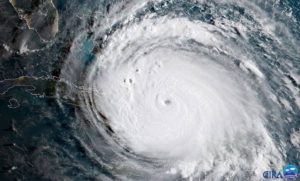
Hurricane Irma as seen from space. (NASA photo)
Hurricane Irma at one point packed 185 mph winds, making it the strongest storm ever recorded in the Atlantic. Had it not turned north after squeezing through the straits between Florida and Cuba it could have headed into the Gulf on a straight line towards the Texas coast, around about Galveston. Irma’s wind speeds reduced as it approached land, but Hurricane Marie hit Puerto Rico at 150 mph. The Galveston lab is built to withstand 140 mph winds.
LeDuc could not deny the impact of climate change.
“It does concern me. I think anybody in their right mind has got to be concerned about the more intensity that we are seeing with storms,” LeDuc admitted to me. “Certainly in our location on the Gulf Coast we are always concerned about that.”
Galveston is Also Sinking
Another worry is that Galveston island is literally sinking. As a barrier island, it is made of sand and seashells built up by centuries of ocean waves 6,000 years ago. Its highest point is only 20 feet.
“These islands, common along the Gulf Coast and East Coast of the United States, are some of the most fragile and changing landforms on Earth. And they are particularly vulnerable to storms,” according to the website Live Science in an article headlined, “Ike Underscores Foolishness of Building on Barrier Islands.”
“Barrier islands like Galveston are particularly vulnerable to storm damage because they are made of sand, as opposed to the hard bedrock that underlies larger islands and the mainland,” the site said.
The Galveston lab is secured with 120-foot pilings dug deep into — sand.
“They also tend to have very low elevations, making it easy for water to wash over and submerge the island,” Live Science said. “Many have questioned the wisdom of choosing to build on and develop barrier islands, given their risks.”
Bob Morton, a geologist at the U.S. Geological Survey’s Center for Coastal and Watershed Studies in St. Petersburg, Florida, told the website:
“Barrier islands are exposed to the open ocean, and the waves and storm surges generated by hurricanes. As a storm makes landfall they’re the ones that are going to receive the strongest winds and the highest wave actions.”
Clark Alexander, a marine geologist at Georgia’s Skidaway Institute of Oceanography, added:
“From a safety standpoint, it’s silly. Because the lifespan of a typical house is something like 60 years. But if you live on a barrier island, you can’t guarantee you’ll have land under your house in 60 years. It’s trying to put something permanent in a place that’s very dynamic.”
A 2013 Houston Chronicle article pointed out that climate-change induced sea-level rise “may pose an even graver problem for Galveston than other coastal areas because the island is sinking at a faster rate than most other areas in the country, a condition known as subsidence.”
Val Marmillion, managing director of America’s Wetland Foundation, told the paper erosion and loss of protective wetlands could shrink Galveston by a third within 30 years.
“The barrier islands are in a very serious situation in all the Gulf Coast states,” Marmillion said. “Galveston, because it is so heavily populated, may be one of the more vulnerable islands we have.”
The Trouble with the Labs
Questions about the safety of biocontainment labs are not only about Galveston. They are nationwide, as a major investigation by USA Today showed in 2015:
“Vials of bio-terror bacteria have gone missing. Lab mice infected with deadly viruses have escaped, and wild rodents have been found making nests with research waste. Cattle infected in a university’s vaccine experiments were repeatedly sent to slaughter and their meat sold for human consumption. Gear meant to protect lab workers from lethal viruses such as Ebola and bird flu has failed, repeatedly.
“A USA TODAY Network investigation reveals that hundreds of lab mistakes, safety violations and near-miss incidents have occurred in biological laboratories coast to coast in recent years, putting scientists, their colleagues and sometimes even the public at risk.
“Oversight of biological research labs is fragmented, often secretive and largely self-policing, the investigation found. And even when research facilities commit the most egregious safety or security breaches — as more than 100 labs have — federal regulators keep their names secret.
“Of particular concern are mishaps occurring at institutions working with the world’s most dangerous pathogens in biosafety level 3 and 4 labs — the two highest levels of containment that have proliferated since the 9/11 terror attacks in 2001. Yet there is no publicly available list of these labs, and the scope of their research and safety records are largely unknown to most state health departments charged with responding to disease outbreaks. Even the federal government doesn’t know where they all are, the Government Accountability Office has warned for years.
“High-profile lab accidents last year with anthrax, Ebola and bird flu at the Centers for Disease Control and Prevention and the discovery of forgotten vials of deadly smallpox virus at the National Institutes of Health raised widespread concerns about lab safety and security nationwide and whether current oversight is adequate to protect workers and the public. …”
The investigation showed that there are biocontainment labs in all 50 states, including in Manhattan and the District of Columbia.
A year earlier, the Houston Chronicle reported that there are no federal guidelines for such labs and no regulatory agency.
“The U.S. Government Accountability Office … released a study that repeated its findings last year that there is still no government agency responsible for overseeing the safety of some 400 laboratories nationwide authorized to handle hazardous biological material,” the Chronicle reported. “The study also found that such laboratories are built without regard for need or assessment of risk and that no national standards exist for their construction and operations.”
In 2013, the Galveston lab lost a vial of a potential bioterror agent and believes it was destroyed. The incident had to be reported to the Centers for Disease Control and Prevention in Atlanta.
LeDuc told me in the phone interview that the Galveston lab follows National Institute of Health guidelines. He said federal inspectors last visited the lab in July and stayed eight days.

Image of Planet Earth taken from Apollo 17
The USA Today investigation also raised the troubling issue of “gain of function” manipulation of microbes, that is, the purposeful fortifying of the viruses by some biocontainment labs.
“At a few labs, experiments have been done with strains of flu and other viruses purposely made to be more dangerous in studies that seek to understand how they might mutate naturally. White House science advisers called for a temporary halt of that kind of ‘gain of function’ research last fall while expert scientific panels spend the next year studying its risks and benefits,” the paper reported.
Le Duc told me in the phone interview that there is no gain of function work done in Galveston although it has been restarted at other labs. He also said no classified research is conducted at the GNL and none of the scientists working there need security clearances.
How the Media Misplayed It
The excellent reporting by USA Today and the Chronicle are exceptions when it comes to media scrutiny of biocontainment labs. This became clear in the case of Galveston. The lab made no statement at all about its condition after Harvey hit for five days and only after my first story was published. LeDuc’s first answers came eight days after that and only after my follow-up story. Given the legitimate concerns about the lab’s location, perhaps a proactive, rather than a reactive response to the public, is warranted.
Sam Husseini, a journalist and communications director for the Institute for Public Accuracy, tweeted: ““Seems to me the lab’s strategy is to lay low and not get media in such a situation bc if it did people would question the wisdom of it.”
In contrast to Galveston, two nuclear power plants in South Florida took a proactive approach, declaring themselves ready in advance of Hurricane Irma in mid-September.
Kramer believes the lab’s lack of transparency may be part of a culture of secrecy that’s emerged from 9/11.
“The focus on concern about ‘terrorism’ and ‘homeland security’ is eroding our ability to know what is going on that might affect our well-being,” he told me. “It is also unfortunately sometimes a convenient excuse for not being forthcoming with the public about operations and risks.”
The lab’s primary work is bio-defense.
LeDuc, however, defended the lab’s reactive public relations strategy.
“I am satisfied with the way we handled communications with the public,” he said.
When I pressed him on whether the lab should have been more proactive, he said he communicated with government agencies, rather than with the public. He’d spoken with the Department of Homeland Security, the White House’s Office of Science and Technology Policy and with the Health and Human Services’ assistant secretary for preparedness.
“They all asked how we were doing and we assured everybody that we were fine,” he said. He assured everybody but the public, that is.
“We are part of the UTMB campus and the campus was fully operational through the storm and our communications guys were answering the phones,” he said. “I think our strategies, our activities were appropriate,” he said, as reactive as they were.
When I pressed LeDuc about the website not having posted a statement, he responded,
“The laboratory is built to withstand hurricanes and it proved its worth during Hurricane Ike. We never even lost power.”
He did admit the lab’s website needed improvement and would be upgraded.
When authorities are not forthcoming, it has traditionally been the role of the press to hold them to account. But in this instance we have had a textbook case of how corporate control of the media can neuter journalism.
Since the lab tried not to draw attention to itself as Hurricane Harvey approached, and issued no statements until days after it struck, it was the press’ job to report the story. This was a significant moment for the lab: the first major hurricane since it opened its doors in November 2008 amid legitimate public concerns.
The response to my report was a Twitter attack on me — mainly by other journalists. John Wayne Ferguson, a reporter from the local Galveston Daily News, demanded I print a correction. But he didn’t respond when I asked him what facts needed to be corrected. When I protested that a story raising concern for the lab was responsible, he answered, “Bullshit.”
A reporter from the Columbus Dispatch chastised me for calling for local coverage: “What are they supposed to write? All’s well at the lab?”
When Hurricane Matthew threatened NASA’s Kennedy Space Station on Cape Canaveral in 2016, there were a slew of stories raising concern before the storm. Afterward, there were stories that the Cape had dodged a bullet with only minimal damage. In other words, “all’s well” at the space station. Before Hurricane Irma hit Florida in mid-September there were again stories about potential danger to Cape Canaveral.
Though the Cape escaped danger both times, the coverage was warranted. Had there been significant damage to an evacuated space station it would have cost the U.S. taxpayer, and perhaps the U.S. some prestige. But it would not have threatened lives, as significant damage could at the Galveston lab.
Flacking for the Lab
The existence of a controversial lab in the backyard of a small paper like the Galveston Daily News in another era would have been a hot story that its editors would have zoomed in on. But that was an era of journalism when defending the community against powerful and often unaccountable institutions was an editorial priority.
Today, too many journalists, driven by careerism, identify with the powerful people they cover, rather than with the interests of their readers. The bigger the stake the journalist has or aspires to have in the corporate system the more she or he will defend it. Self-interest, not public interest, becomes the motivating factor. A careerist does not rock the boat. A journalist who doesn’t rock the boat has no business being a journalist.
The Galveston Daily News wrote nothing about the lab until six days later when it ran a hit piece against me titled, “Rumor Central.” But it went further. Both the local and national media worked with the university’s communications office to silence the story. It is an illustration of who is winning the long-running battle between public relations and the press.
My first article raising concern was published on Consortiumnews, the Huffington Post and in the pages of the Johannesburg Star, the Cape Argus and the Pretoria News in South Africa. The university’s communications office and Ferguson of the Daily News teamed up to try to get the article retracted. As Husseini tweeted: “Reporters like @johnwferguson should not be flacking for the lab. It was legit to raise concerns; the lab should give public facts.”
Christopher Gonzalez Smith of the communications office posted a readers’ comment under the Consortiumnews article that said:
“This story is not correct. There was no breach of any sort during the storm. The GNL had no damage or loss of either physical or biological security. “
He apparently sent the same message to my editor in South Africa, who called it out for the lie that it is. He wrote me,
“We never said there was a breach, but only fears of a breach.”
My editor refused to retract the article and asked for a follow-up story.
Of the three places the article was published, only The Huffington Post caved to the pressure. An editor there broke a newsroom rule by pulling the story without first contacting the writer. She simply informed me after the fact, with the reasons that LeDuc made a statement (only in reaction to my piece), that the lab was safe, and that no other news organization had the story. I told her the reason no one else had the story was because it was exclusive. I’ve had colleagues over the years tell me the same thing: their editors rejected stories because the rest of the media herd didn’t have it.
My appeals to The Huffington Post to restore the article because it contained no factual errors, no libel and no plagiarism were met with no response. It had a knock-on effect. Esquire magazine had linked to my Huffington Post article in a story about environmental hazards in Texas during the storm. Ferguson, ostensibly a reporter, did the lab’s work by complaining to Esquire about my piece. The magazine gave in when they saw The Huffington Post retraction and published a clarification, thanking Ferguson by name and promising to do a better job in the future.
I contacted the Esquire writer, Charles Pierce, explaining that neither Consortiumnews, nor the Johannesburg Star and the other South African papers had retracted. The Huffington Post was the odd one out. I told him he’d been right the first time to link to my piece and asked that the clarification be removed. Pierce totally ignored me, uninterested in the damage his mistaken clarification had done.
The Oregonian also published a piece about the retracted article, quoting the Huffington Post editor who nixed my story. “Galveston lab that houses deadly airborne viruses not in danger from flood; HuffPost pulls fear-raising story,” was the headline.
In naming me in the article, the reporter, Douglas Perry, broke two of the most basic rules of journalism: one, there are two sides to a story, and two, if you name someone in an article, especially negatively, you need to try to contact that person for comment. The reporter did neither. He also falsely reported that my quotes from Boyle had come from 2008, when they came from a current interview, giving the false impression that the concerns were old.
I asked Perry why he deemed the Huffington Post‘s voice in his story the only valid one? In journalism that favors the powerful, the institution’s voice is heard and rarely the individual contesting it. His article had a serious factual error and gave only one side of the story but it smeared me by name for an article I wrote with no errors, and which was balanced with the lab’s stated hurricane precautions spelled out. Eventually Perry corrected the Boyle quote and updated his story with a quote from me, not inserted into the body of the article but tagged to the end:
Joe Lauria responds:
“I wrote the same story for the Johannesburg Star and two other South African papers, as well as for Consortiumnews.com, and only the Huffington Post wrongly retracted it, apparently based on a false statement from a lab spokesman who said my article had reported a breach had occurred. My story never reported that. The concerns for a lab in a hurricane zone are real and ongoing.”
Indeed, as Kramer said, despite the belated reassurances of LeDuc about the precautions taken, the placement of the lab without federal oversight on an endangered barrier island remains questionable, especially as storms of greater than 140 mph winds are more possible than ever in this dire age of climate change.
Joe Lauria is a veteran foreign-affairs journalist. He has written for the Boston Globe, the Sunday Times of London and the Wall Street Journal among other newspapers. He is the author of “How I Lost By Hillary Clinton” published by OR Books. He can be reached at [email protected] and followed on Twitter at @unjoe.

